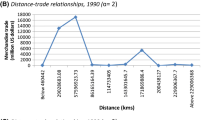Abstract
The objective of this paper is to apply a modified gravity model to annual exports disaggregated by sector, from MERCOSUR + Chile to the 15 current members of the EU. In doing so, we aimed to classify sectors according to their sensitivity to geographical and economic distance and to identify which commodities enjoy export strength even without further progress in trade liberalisation with the EU. In the estimation we made use of two additional explanatory variables which are found to be relevant when explaining trade, namely, infrastructure and exchange rates. An exchange rate index is built that takes into account protection. Our results support the view that different sectors have a different sensitivity to distance and highlight the importance of using disaggregated data when analysing international trade flows.
Similar content being viewed by others
References
Anderson, James E. (1979) “A Theoretical Foundation for the Gravity Equation.” American Economic Review 69:106–116.
Anderson, James E. and Eric van Wincoop (2001) “Gravity with Gravitas: A Solution to the Border Puzzle.” National Bureau of Economic Research Working Paper 8079. Cambridge, Massachusetts, USA.
Arnon, A., Spivak, A. and Weinblatt, J. (1996) “The Potential for Trade Between Israel, the Palestinians and Jordan.” World Economy 19:113–134.
Balaguer-Franch, Ma José and Inmaculada Martinez-Zarzoso (2000) “An álisis de los Flujos Comerciales UE-MERCOSUR.” Informaci òn Comercial Espa ñ ola. Revista de Economia 788:119–132.
Bhargava, Alok, Luisa Franzini and Wiji Narendranathan (1983) “Serial Correlation and the Fixed Effects Model.” Review of Economic Studies, 49:533–549.
Bergstrand, Jeffrey H. (1985) “The Gravity Equation in International Trade: Some Microeconomic Foundations and Empirical Evidence.” The Review of Economics and Statistics 67:474–481.
Bergstrand, Jeffrey H. (1989) “The Generalised Gravity Equation, Monopolistic Competition, and the Factor-Proportions Theory in International Trade.” The Review of Economics and Statistics 67:474–481.
Bougheas, Spiros, Panicos Demetriades, and Edgar Morgenroth (1999) “Infrastructure, Transport Costs and Trade.” Journal of International Economics 47:169–189.
Breuss, Fritz and Peter Egger (1999) “How Reliable are Estimations of East-West Trade Potentials Based on Cross-Section Gravity Analyses?” Empirica 26(2):81–95.
Carrillo, Carlos and Carmen A Li (2002) “Trade Blocs and the Gravity Model: Evidence from Latin American Countries.” Mimeo. Department of Economics, University of Essex, England.
Chen, I-Hui and Howard J. Wall (1999) “Controlling for Heterogeneity in Gravity Models of Trade.” Federal Reserve Bank of St. Louis Working Paper 99-010A.
Deardorff, Alan V. (1995) “Determinants of Bilateral Trade: Does GravityWork in a NeoclassicWorld? National Bureau of Economic Research Working Paper 5377. Cambridge, MA, USA.
Diao, Xinshen and Agapi Somwaru (2000) “An Inquiry on General Equilibrium Effects of MERCOSUR: An Intertemporal World Model.” Journal of Policy Modelling 22(4):557–588.
Egger, Peter (2000) “A Note on the Proper Econometric Specification of the Gravity Equation.” Economics Letters 66:25–31.
Endoh, Masahiro (2000) “The Transition of Post-War Asia-Pacific Trade Relations.” Journal of Asian Economics 10(4):571–589.
Helpman, Elhanan and Paul Krugman (1985) Market Structure and Foreign Trade. Increasing Returns, Imperfect Competition, and the International Economy. Cambridge, MA/London: The MIT Press.
Hirsch, Seev, Igal Ayal, and Gideon Fishelson (1995) “The Arab-Israely Trade Potential: Methodological Considerations and Examples.” In M. Kreinin (ed.) Contemporary Issues in Comercial Policy. New York: Pergamon Press.
Hirsch, Seev and Niron Hashai (2000) “The Arab-Israeli Trade Potential: The Role of Distance-Sensitive Products.” The International Trade Journal 14(1):1–35.
Limao, Nuño and Anthony J. Venables (2001) “Infrastructure, Geographical Disadvantage and Transport Costs.” World Bank Economic Review 15(3):451–479.
Linder, Staffan B. (1961) An Essay on Trade and Transformation, New York: Wiley & Sons.
Loser, Claudio and Martine Guerguil (1999) “Trade and Trade Reform in Latin America and the Caribbean in the 1990s.” Journal of Applied Economics II(1):61–96.
Martín, Carmela (2000) The Spanish Economy in the New Europe. London: Macmillan Press.
Martínez-Zarzoso, Inmaculada and Felicitas Nowak-Lehmann (2001) “Augmented Gravity Model: An Empirical Application to MERCOSUR-European Union Trade Flows.” Journal of Applied Economics VI(2):269–294.
Martinez-Zarzoso, Inmaculada and Susana Valencia-Parrilla (2001) “Estructura y evoluci òn del comercio exterior de MERCOSUR.” Informaci òn Comercial Espa ñ ola. Revista De Economía 790:119–140.
Mcpherson, Michael A., Michael R. Redfearn, and Margie A. Tieslau (2000) “A Re-Examination Of The Linder Hypothesis: A Random-Effects Tobit Approach.” International Economic Journal 14(3):123–136.
Màtyàs, LàszlÓ (1997) “Proper Econometric Specification of the Gravity Model.” TheWorld Economy 20(3):363–368.
Pöyöhnen, Pentti (1963) “A Tentative Model for the Volume of Trade between Countries.” Weltwirtschaftliches Archiv 90:93–99.
Soloaga, Isidro and Alan Winters (1999) “Regionalism in the Nineties: What Effects on Trade?" Development Economic Group of the World Bank, mimeo.
Supper, Erich (2001) “Is there Effectively a Level Playing Field for Developing Countries Exports?” UNCTAD , Policy Issues in International Trade and Commodities , Study Series No. 1.
Tinbergen, Jan (1962) Shaping the World Economy. Suggestions for an International Economic Policy. New York.
Ventura-Dias, Vivianne, Maria Cabezas, and Jaime Contador (1999) “Trade Reforms and Trade Patterns in Latin America.” Series de Comercio Internacional de la CEPAL, LC/L.1306-P/I.
WTO Trade Policy Review, European Union (1995, 1997, 2000) World Trade Organisation, Geneva.
Yeats, Alexander J. (1998) “Does MERCOSUR''s Trade Performance Raise Concerns about the Effects of Regional Rrade Arrangements?” The Word Bank Economic Review 12(1):1–28.
Author information
Authors and Affiliations
Rights and permissions
About this article
Cite this article
Martínez-Zarzoso, I., Nowak-Lehmann, F.D. Economic and Geographical Distance: Explaining Mercosur Sectoral Exports to the EU. Open Economies Review 15, 291–314 (2004). https://doi.org/10.1023/B:OPEN.0000037702.33704.20
Issue Date:
DOI: https://doi.org/10.1023/B:OPEN.0000037702.33704.20




